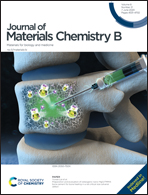Ternary hydrogels with tunable mechanical and self-healing properties based on the synergistic effects of multiple dynamic bonds
Abstract
The composite hydrogel of gelatin (Gel) and oxidized sodium alginate (OSA) is often used in biomedical fields due to its good biocompatibility. However, the typical utility of borax and weak mechanical properties are not preferred either in the cell environment or as a supporting scaffold. Herein, poly(vinyl alcohol) (PVA) is mixed with Gel and OSA to construct a ternary hydrogel Gel–OSA–PVA so as to improve the mechanical properties and reduce toxicity. The hydrogel possessed tunable mechanical properties by adjusting the concentrations of PVA and the oxidized degrees of OSA, related closely to the dynamic imine bonds and multiple hydrogen bonds among these macromolecules. In terms of the effects of OSA, its aldehyde group content played a more important role in enhancing the compressive modulus of hydrogels compared to its change of molecular weight/chain length. These multiple dynamic bonds also endowed the Gel–OSA–PVA hydrogel with good self-healing performance. Interestingly, the hydrogels presented great conductivity due to the existence of free ions, varying with the deformation of hydrogels, and showed great potential in promoting osteogenesis. Together with the absence of cytotoxicity and antibacterial properties, the hydrogel is a potential candidate for applications in the biomedical field.



 Please wait while we load your content...
Please wait while we load your content...